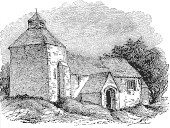
Early Christianity in Wales 2
The Welsh saints
What manner of men these "saints" were and the exact nature of the communities they founded are difficult to determine. Most of the surviving lives of the Welsh saints were written from an eleventh or twelfth century perspective. Similarly a study of the dedications of churches aimed at uncovering the activities of an individual founding saint is also fraught with difficulties. Many churches were dedicated to a saint long after his death at a time when his cult was fashionable, or had been acquired by the mother house of a saint after his death.
Montgomeryshire
 that these early foundations were
monastic in nature however, but there were no great organised
monastic orders with standardised practises at this time and
it is likely that there were local variations. Some foundations
do seem to be communities of professed monks living a life of
worship, labour and prayer, while others seem to be looser associations
of like-minded people.
that these early foundations were
monastic in nature however, but there were no great organised
monastic orders with standardised practises at this time and
it is likely that there were local variations. Some foundations
do seem to be communities of professed monks living a life of
worship, labour and prayer, while others seem to be looser associations
of like-minded people.The foundations do not seem to be those of a single parish clergyman ministering to a scattered congregation. Even those communities of professed monks were led by clergy who married and produced children, and inheritance of religious office was common in Wales up to the 12th century. It was common for a community to be led by a lay abbot who had inherited the post. It would seem likely that practices reflect the fact that these kinship groups were part of a tribal nobility and the paying of fees on entering a community may have been the norm. Once established some of these communities would branch out under their leader to form daughter houses under their control. Some of these ‘mother’ churches or clasau had their own bishops although is difficult to determine quite how far their influence stretched.
There are 3 pages on early Christianity in Wales. Use the box links below to view the other pages.